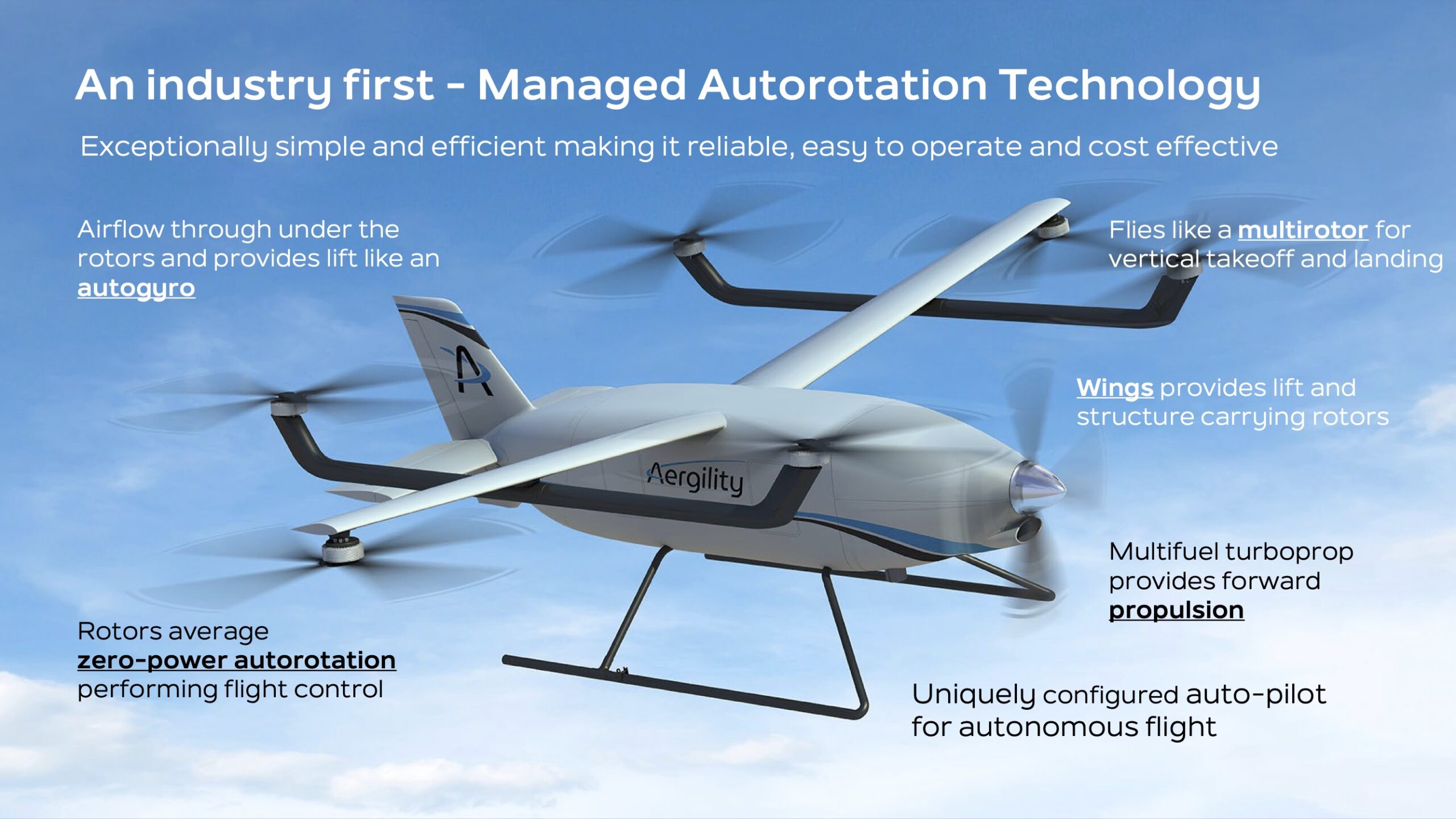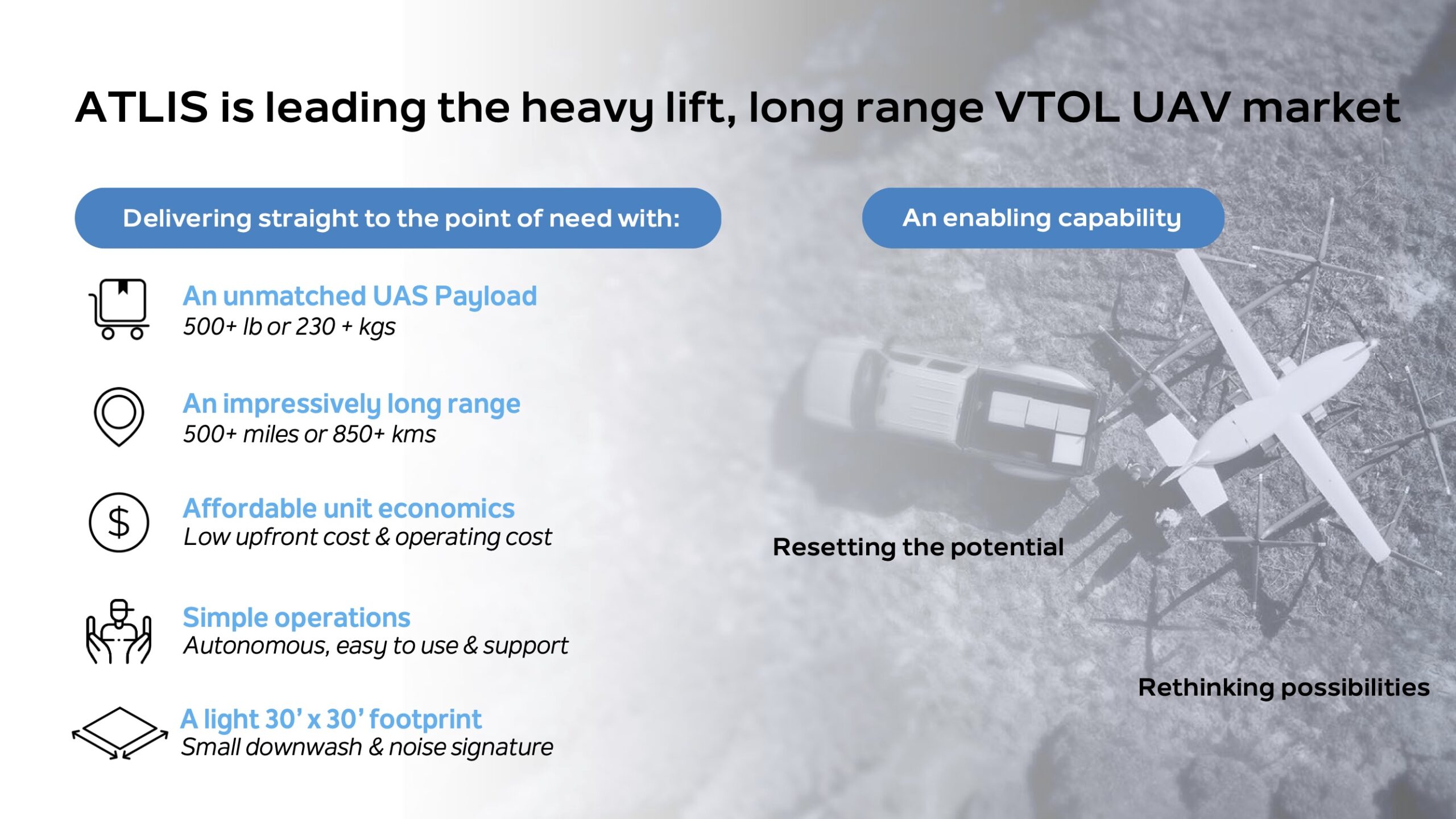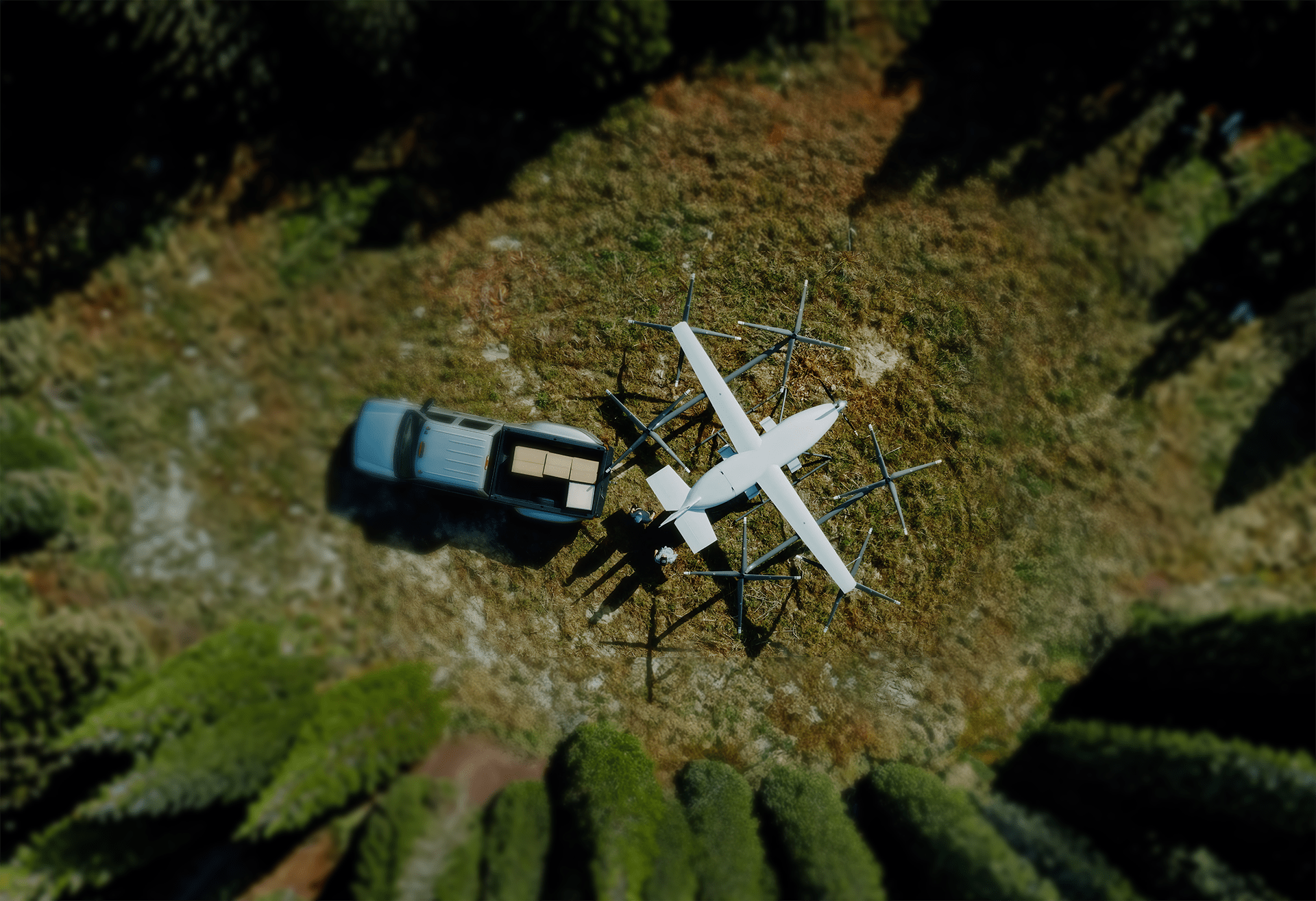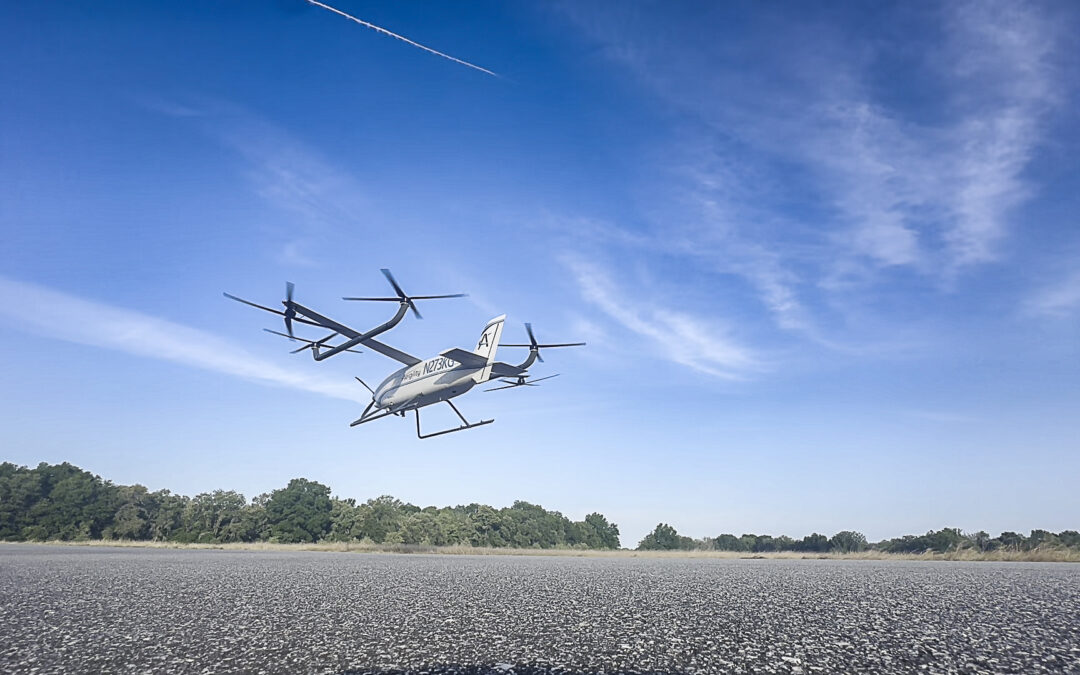By Scott Simmie
A US-based company called Aergility just hit a major milestone worth recognising. The company’s uncrewed cargo vehicle, called ATLIS, successfully completed multiple untethered test hovers on May 10.
This is a big deal on the path toward commercialisation for Aergility, which has designed an aircraft unlike any other we’ve seen. It’s a VTOL with a small fixed wing that also employs managed autogyro technology to assist in lift.
We first saw this just over two years ago in Florida, at the AUVSI show. The company was attracting a lot of attention because of its range (800km/500 miles) and payload capabilities (300 pounds then; since upgraded to 500 pounds).
At the time, the product on the floor still required further integration and FAA permission before test flights could commence. Last fall, Aergility conducted successful tethered test flights – but this was the first time it was in a free hover, manually controlled by a pilot. In all, there were four test hovers, each lasting roughly a minute. Pitch, yaw and control functions were successfully tested. The aircraft also flew out of ground effect mode, to a height of six metres (20′).
“The solid performance of ATLIS in its initial and subsequent hover flights gives us the confidence to move to forward flight testing in early June. We are excited about demonstrating the full potential of ATLIS to our stakeholders,” said Jim Vander Mey, CEO of Aergility Corporation.
We’ll get into far more details about this aircraft in a moment. But first, here’s a look at a video Aergility just posted showcasing the event.
A CLOSER LOOK AT ATLIS
The beauty of ATLIS is its simplicity.
Takeoff (and hovering) is accomplished by six electrically powered rotors (the commercial version will feature eight rotors in four coaxial pairs for redundancy purposes).
Once airborne, the front tractor turboprop spins up and the aircraft begins forward flight with no awkward transition. The VTOL stage of flight lasts only about 30 seconds, so ATLIS doesn’t need to carry massive batteries.
As the forward speed increases, the power supplied to the lifting motors is reduced and eventually tapers to net zero when ATLIS reaches reaches an airspeed of 112-128 km/hr (70-80 mph). In forward flight, airspeed spins the lifting rotors.
But these rotors aren’t simply freely spinning. Remember this is “managed autogyration” – which means ATLIS is in control of the RPMs at all time – with the ability to slow some or speed up others.
CONTROL SURFACES
Although there are control surfaces for testing in the current version of ATLIS (trim tabs and a rudder for slow-speed manoeuvering), the eventual version for clients will have no control surfaces. Pitch, roll and yaw functions in both hover and forward flight operate in a similar fashion to a standard quadcopter, with variations in speed between the different lifting rotors resulting in the desired manoeuvre.
“To summarize the technology, essentially the aircraft takes off and lands vertically like a normal multi-rotor aircraft,” says Brian Vander Mey.
“But in forward flight the power for our rotors slowly tapers off until it’s down to zero net power for forward flight…(that’s where) our rotors go into a state that we call managed autorotation. It is called that because of the fine control we have over the autorotation state, allowing us to stay at net zero power while still having attitude and maneuvering control – which would expend net power in a quadcopter.”
Remember, Aergility is in control of those RPMs at all times. That means if pitch, yaw or roll are required, it can accomplish this by putting the brakes on the appropriate rotors and speeding up others. In doing so, similar to a Tesla, regenerative braking is involved.
“So if we need to make some sort of a banking maneuver, we may accelerate rotors on one side and brake rotors on the other side, which both consumes and generates power, but in equal proportions. So we end up maintaining net zero power usage across the whole system.”
In other words, the energy created by putting the brakes on one rotor generates electricity that is applied to another. Because of this design, ATLIS doesn’t have to carry much battery power, which means lower battery weight and greater payload capacity.
“That means that our range is only limited by the amount of fuel that we have on board.”
Below: An image from an Aergility information deck shows how the system works

REMOTE LOCATIONS, LIMITED INFRASTRUCTURE
Its impressive payload capacity and range make ATLIS ideal for getting critical cargo to remote locations, or places with limited infrastructure. It requires only a 9m x 9m (roughly 30′ x 30′) space for takeoff of landing, and the company says it has a small downwash and noise signature.
This makes it ideal, says Brian Vander Mey, for multiple use-case scenarios. It is perfect, he says, for “anywhere that is difficult to access due to its remoteness, or where the cost of getting there is prohibitive, or areas with non-existent, limited, or damaged infrastructure.”
He then offers a few examples:
“This could include places like Puerto Rico, where all of the roads were destroyed by Hurricane Maria. It could be used in mining, oil & gas – really anywhere that fits that profile that it’s hard, dangerous or expensive to get there via other means.
“Canada may be one of the biggest potential opportunities. We’ve spoken with Canada Post and learned of the challenges delivering to the northern regions and First Nations communities, and with the massive wildfire problems, this aircraft can address remote support.”
CEO Jim Vander Mey adds: “We look forward to the impact this technology will have on various industries, including logistics, disaster relief, and military applications.”
COMMERCIAL VERSION
The current version of ATLIS will be going through further testing, starting with forward flight in June of 2024. Meanwhile, the team is also looking ahead to a new iteration of ATLIS intended for production for clients. Lessons have been learned – as always in R&D – that can help improve the next generation. The cargo hold will be larger and modular, the rotors will be higher off the ground to allow ground crews to move safely below the aircraft, and the previously mentioned eight-rotor coaxial VTOL system will be incorporated.
“That will enable us to lose one to two rotors and still complete a mission – not simply just be able to get down to the ground under control,” says Brian Vander Mey.
And remember how ATLIS is only required to carry minimal batteries because the period of hovering is quite brief? An onboard generator that’s part of the turboprop engine recharges those batteries completely in as little as eight to 10 minutes during forward flight. And if that generator stops working? Aergility has a solution for that, as well.
“In the event the generator was to fail, we can change the angle of attack of the aircraft,” he says.
In other words, pitch down slightly to increase the airspeed spinning those VTOL rotors.
“So the entire aircraft has more aerodynamic energy coming across the rotors and we can recharge directly off of the rotors from forward flight without the the intermediate generator on the motor.”
As stated, this machine can fly 800 kilometres (500 miles) carrying 227 kg (500 pounds). That also means it could fly shorter distances with a heavier payload – or an exceptionally long range if the payload is additional fuel. Vander Mey says the commercial version of ATLIS will be able to fly some 3,400km (1900 miles) if that cargo bay is carrying additional fuel as its payload.
Below: More data from a supplied Aergility information deck:

THE COMING WORLD OF AAM
Uncrewed cargo vehicles like ATLIS will play an important role in the coming world of Advanced Air Mobility – where airspace is shared between traditional aircraft and this new generation of vehicles. The FAA and Transport Canada have their own long-term plans on achieving this integrated airspace and both regulators are fully onboard with this vision of the future. Uncrewed vehicles will (generally) offer more sustainable flight, and be able to drop into locations unreachable except by helicopters at a reduced cost.
We’ve written about this world at length here. It’s also worth mentioning that in Canada, the lobby organization the Canadian Advanced Air Mobility Consortium is working closely with regulators and the industry to ensure a smooth transition forward.
There’s no question that under-serviced areas and remote locations – including those with zero traditional aviation infrastructure – will benefit greatly. There’s also, of course, the important use-cases of getting emergency supplies into disaster zones.
That world isn’t going to happen tomorrow. Nor is the FAA certification of ATLIS – a meticulous and time-consuming process that will truly begin when the commercial version of the aircraft is built. In the meantime, Aergility is operating with a Special Airworthiness Certificate (SAC-EC) from the FAA. It also has Certificates of Authorization (COAs) that cover an area near its local hangar, which grants permission for forward flight testing within a specific area (roughly 10 square miles, or 2,590 hectares). It also allows for flights at higher altitudes.
WAIVERS
When it comes to commercial applications, Aergility knows that process will be lengthy. It’s following standards set up by ASTM International during all phases of design, construction and testing.
“Industry standards are being developed through organizations like ASTM,” says Brian Vander Mey. “We expect that by aligning our processes with what ASTM is developing, that will be the the cleanest path to permission to operate in the US.”
And until that coveted certification is reached? Aergility says FAA Waivers for specific operations will be obtained to enable commercial flights for operations until then.
“We don’t need Waivers for our own testing because of our special FAA permissions. But potentially we’ll have clients initially flying under Waivers.”

INDRO’S TAKE
We were impressed with ATLIS from the moment we first saw the vehicle. Its cargo capacity and range filled a void, and the managed autogyration is an ingenious concept. But it’s one thing to see a static, non-functioning display on a convention floor – and quite something else to see this machine carry out multiple stable hovers.
“Aviation R&D is a very tricky business, and becomes more complex with larger aircraft intended for eventual certification,” says InDro Robotics CEO Philip Reece.
“This is an incredible milestone for ATLIS and the Aergility team. We see great potential for this aircraft in multiple use-case scenarios, and look forward to success in the upcoming forward flights.”
To learn more about Aergility and its progress, check out its website here. You can also follow Aergility on LinkedIn here.

